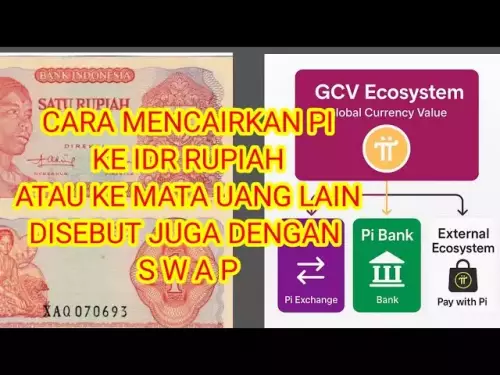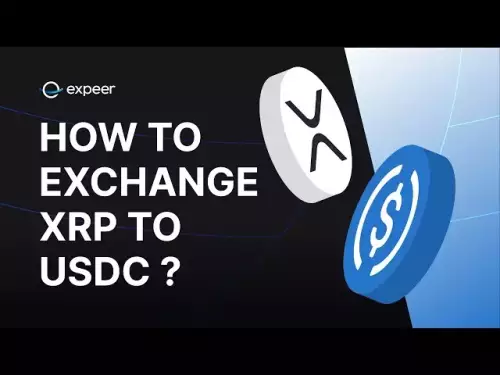-
 bitcoin
bitcoin $112715.707551 USD
-1.71% -
 ethereum
ethereum $4101.475385 USD
-3.01% -
 tether
tether $1.000644 USD
-0.02% -
 bnb
bnb $1207.619465 USD
-6.77% -
 xrp
xrp $2.501451 USD
-3.98% -
 solana
solana $202.947124 USD
-3.32% -
 usd-coin
usd-coin $1.000295 USD
0.04% -
 dogecoin
dogecoin $0.203884 USD
-4.47% -
 tron
tron $0.317154 USD
-1.72% -
 cardano
cardano $0.695009 USD
-4.43% -
 hyperliquid
hyperliquid $38.853961 USD
-8.23% -
 chainlink
chainlink $18.988674 USD
-4.64% -
 ethena-usde
ethena-usde $1.000233 USD
-0.03% -
 stellar
stellar $0.337050 USD
-3.63% -
 bitcoin-cash
bitcoin-cash $536.861728 USD
-1.28%
Is it cost-effective to hold HBAR for a long time? What risk factors need to be considered?
Holding HBAR long-term may offer value appreciation and staking rewards, but consider risks like market volatility, regulatory changes, and tech issues.
Apr 29, 2025 at 04:56 pm

Is it cost-effective to hold HBAR for a long time? What risk factors need to be considered?
Holding HBAR, the native cryptocurrency of the Hedera Hashgraph network, for the long term can be an attractive proposition for many investors. However, the decision to hold any cryptocurrency over an extended period involves weighing potential benefits against various risk factors. In this article, we will explore the cost-effectiveness of holding HBAR long-term and the key risk factors that investors should consider.
Understanding HBAR and Hedera Hashgraph
HBAR is the cryptocurrency that powers the Hedera Hashgraph platform, a distributed ledger technology designed to offer high throughput, low latency, and fair ordering of transactions. The Hedera network aims to provide a more efficient alternative to traditional blockchain systems, which can be slower and more energy-intensive. Hedera Hashgraph uses a unique consensus algorithm called Hashgraph, which is claimed to be more scalable and secure than traditional blockchain consensus mechanisms.
Potential Benefits of Holding HBAR Long-Term
One of the primary reasons investors might consider holding HBAR for the long term is the potential for appreciation in value. As the Hedera network grows and more applications are built on it, the demand for HBAR could increase, potentially driving up its price. Additionally, HBAR is used to pay for transaction fees and other services on the Hedera network, which could create a steady demand for the token.
Another benefit of holding HBAR is the potential for staking rewards. Hedera allows users to stake their HBAR to help secure the network and, in return, receive a portion of the transaction fees generated on the network. This can provide a passive income stream for long-term holders, adding to the overall cost-effectiveness of holding HBAR.
Risk Factors to Consider
While there are potential benefits to holding HBAR long-term, there are also several risk factors that investors need to consider. One of the primary risks is market volatility. Cryptocurrencies, including HBAR, are known for their price fluctuations, which can lead to significant losses if the market moves against the investor's position.
Another risk factor is regulatory uncertainty. The cryptocurrency industry is still relatively new and is subject to evolving regulations in different jurisdictions. Changes in regulations could impact the operation of the Hedera network and the value of HBAR. Investors need to stay informed about regulatory developments that could affect their investment.
Technological risks are also a concern. While Hedera Hashgraph is designed to be a more efficient and scalable solution than traditional blockchains, there is always the possibility of unforeseen technical issues or vulnerabilities that could impact the network's performance and, consequently, the value of HBAR.
Evaluating the Cost-Effectiveness of Holding HBAR
To determine whether holding HBAR is cost-effective in the long term, investors need to consider both the potential benefits and the risk factors. The potential for price appreciation and staking rewards can make HBAR an attractive long-term investment. However, the risks of market volatility, regulatory uncertainty, and technological issues must be carefully weighed.
Investors should also consider their investment goals and risk tolerance. Those with a higher risk tolerance and a long-term investment horizon may find HBAR to be a suitable addition to their portfolio. Conversely, investors who are more risk-averse or have a shorter investment horizon may want to approach HBAR with caution.
Strategies for Managing Risk
To manage the risks associated with holding HBAR long-term, investors can employ several strategies. Diversification is one of the most effective ways to mitigate risk. By spreading investments across different assets, investors can reduce their exposure to any single cryptocurrency, including HBAR.
Another strategy is to stay informed about developments in the Hedera ecosystem and the broader cryptocurrency market. Keeping up with news and updates can help investors make more informed decisions about when to buy, hold, or sell HBAR.
Setting stop-loss orders can also be a useful tool for managing risk. A stop-loss order automatically sells a portion of the investor's HBAR if the price falls to a certain level, helping to limit potential losses.
Practical Steps for Holding HBAR Long-Term
For those who decide to hold HBAR for the long term, here are some practical steps to consider:
Choose a reputable exchange: Select a well-established cryptocurrency exchange that supports HBAR trading. Ensure the exchange has strong security measures in place to protect your assets.
Secure your HBAR: Transfer your HBAR to a secure wallet. Hardware wallets are generally considered the most secure option for long-term storage. Software wallets can also be used, but they may be more vulnerable to hacking.
Set up staking: If you are interested in earning staking rewards, set up a staking account on the Hedera network. Follow the platform's instructions to stake your HBAR and start earning rewards.
Monitor your investment: Regularly check the performance of your HBAR holdings and stay updated on news and developments related to Hedera Hashgraph. Adjust your strategy as needed based on market conditions and your investment goals.
Frequently Asked Questions
Q: How does the Hedera Hashgraph consensus mechanism differ from traditional blockchain consensus mechanisms?A: The Hedera Hashgraph consensus mechanism, known as Hashgraph, uses a gossip protocol and virtual voting to achieve consensus. Unlike traditional blockchain consensus mechanisms like Proof of Work or Proof of Stake, Hashgraph does not require mining and is designed to be more efficient and scalable. It achieves fair ordering of transactions and can handle a high volume of transactions with low latency.
Q: Can HBAR be used for purposes other than transaction fees and staking on the Hedera network?A: Yes, HBAR can be used for various purposes within the Hedera ecosystem. It can be used to pay for smart contract execution, file storage, and other services on the network. Additionally, some decentralized applications (dApps) built on Hedera may use HBAR as a utility token within their ecosystems.
Q: How can I stay updated on the latest developments related to Hedera Hashgraph and HBAR?A: To stay updated on the latest developments, you can follow the official Hedera Hashgraph blog and social media channels. Joining online communities and forums dedicated to Hedera and HBAR can also provide valuable insights and updates. Subscribing to cryptocurrency news websites and newsletters that cover Hedera can help you stay informed about market trends and regulatory changes.
Q: What are some signs that it might be time to sell my HBAR holdings?A: Some signs that it might be time to sell your HBAR holdings include significant negative news or developments related to Hedera Hashgraph, a prolonged downtrend in the price of HBAR, or changes in your personal financial situation or investment goals. It's important to regularly review your investment strategy and make adjustments as needed based on these factors.
Disclaimer:info@kdj.com
The information provided is not trading advice. kdj.com does not assume any responsibility for any investments made based on the information provided in this article. Cryptocurrencies are highly volatile and it is highly recommended that you invest with caution after thorough research!
If you believe that the content used on this website infringes your copyright, please contact us immediately (info@kdj.com) and we will delete it promptly.
- Tokenization Takes Center Stage: SEC-Registered Stock Tokens Reshape Finance
- 2025-10-15 22:25:13
- Bitcoin Seized, Transferred: A New York Minute on Crypto's Wild Ride
- 2025-10-15 22:25:13
- Milk & Mocha's $HUGS: Can This Crypto Presale Deliver a 100x Portfolio?
- 2025-10-15 22:30:01
- Memecoins Grow Up: $HUGS Presale Offers Real Utility
- 2025-10-15 22:45:13
- HUGS Launch, Crypto Bull Run, and a Perfect Storm Brewing?
- 2025-10-15 22:45:13
- Zero Knowledge Proof, Whitelists, and the Future of Blockchain Privacy
- 2025-10-15 22:30:01
Related knowledge

Practical parameter settings for a Bitcoin multi-timeframe moving average system
Sep 18,2025 at 10:54pm
Optimizing Timeframe Combinations for Bitcoin Trading1. Selecting appropriate timeframes is crucial when building a multi-timeframe moving average sys...

How can I filter out false breakouts in Dogecoin high-frequency trading?
Sep 22,2025 at 01:00am
Understanding False Breakouts in Dogecoin Trading1. A false breakout occurs when Dogecoin's price appears to move beyond a defined support or resistan...

Techniques for identifying tops and bottoms in the Bitcoin on-chain NVT model
Sep 20,2025 at 07:54pm
Understanding the NVT Model in Bitcoin Analysis1. The Network Value to Transactions (NVT) ratio is often described as the 'P/E ratio' of the cryptocur...

What does the surge in open interest in Bitcoincoin futures mean?
Sep 20,2025 at 11:18pm
Understanding the Surge in Dogecoin Futures Open Interest1. A surge in open interest within Dogecoin futures indicates a growing number of active cont...

How can I use the Ethereum USDT premium to gauge market sentiment?
Sep 18,2025 at 11:55pm
Understanding the Ethereum USDT Premium1. The Ethereum USDT premium refers to the price difference between USDT (Tether) traded on Ethereum-based plat...

What should I do if Ethereum staking yields decline?
Sep 20,2025 at 06:18am
Understanding the Causes Behind Declining Ethereum Staking Yields1. The Ethereum network transitioned to a proof-of-stake consensus mechanism with the...

Practical parameter settings for a Bitcoin multi-timeframe moving average system
Sep 18,2025 at 10:54pm
Optimizing Timeframe Combinations for Bitcoin Trading1. Selecting appropriate timeframes is crucial when building a multi-timeframe moving average sys...

How can I filter out false breakouts in Dogecoin high-frequency trading?
Sep 22,2025 at 01:00am
Understanding False Breakouts in Dogecoin Trading1. A false breakout occurs when Dogecoin's price appears to move beyond a defined support or resistan...

Techniques for identifying tops and bottoms in the Bitcoin on-chain NVT model
Sep 20,2025 at 07:54pm
Understanding the NVT Model in Bitcoin Analysis1. The Network Value to Transactions (NVT) ratio is often described as the 'P/E ratio' of the cryptocur...

What does the surge in open interest in Bitcoincoin futures mean?
Sep 20,2025 at 11:18pm
Understanding the Surge in Dogecoin Futures Open Interest1. A surge in open interest within Dogecoin futures indicates a growing number of active cont...

How can I use the Ethereum USDT premium to gauge market sentiment?
Sep 18,2025 at 11:55pm
Understanding the Ethereum USDT Premium1. The Ethereum USDT premium refers to the price difference between USDT (Tether) traded on Ethereum-based plat...

What should I do if Ethereum staking yields decline?
Sep 20,2025 at 06:18am
Understanding the Causes Behind Declining Ethereum Staking Yields1. The Ethereum network transitioned to a proof-of-stake consensus mechanism with the...
See all articles










































































